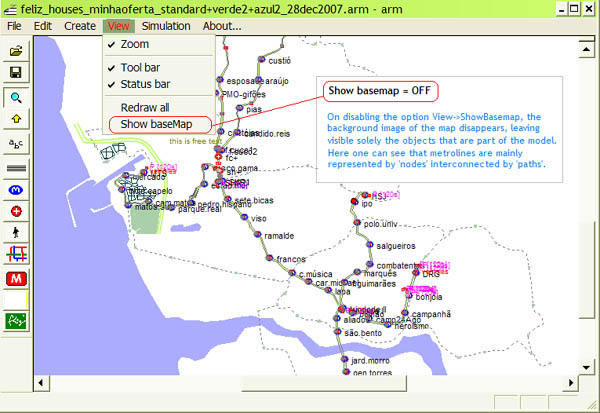 |
version
for WindowsXP
|
| Main window | Main toolbar | Operation's theatre | Edit menu | Create menu | Basemap on | About simulation | About MetroSim | About zooming | Basemap off | Model elements | Paths, nodes and CSUs | |
|
Main window: The main window, where models will be created, displayed and run. |
 |
|
|
|
|
Main toolbar: From the main toolbar you have direct access to some basic issues, like: Opening and SaveAs models; Zoom facility, by defining the target rectangle; Insert free text; etc. You can also Inspect and configure the metrolines in the system. Visit the client's and sponsor's websites. Visit the Author's website. |
 |
|
|
|
|
Operation's theatre: The operation's theatre is the base rectangle where the model is to be drawn. The spatial dimensions are given in Km. These have to be defined when the model is created. Down, at the window's border, the coordinates of the mouse will be continuously displayed. |
 |
|
|
|
|
Edit menu: See the figure for details about this menu option. |
 |
|
|
|
|
Create menu: This menu option lets you create several types of objects, in particular the network nodes. See the figure for details. |
 |
|
|
|
|
Basemap on: The bitmap image 'basemap.bmp' will be displayed in the application's window whenever the option View->ShowBasemap is enabled. This will happen only if the 'basemap.bmp' file exists in the same directory of the model that is opened. This is useful mainly for the process of creating the structure of the model: that is, its paths, stations and nodes. In the simulation process it is a mere visual effect. |
 |
|
|
|
|
About Simulation: In this menu option some useful aspects for the simulation process are defined: start the simulation; how will random variables behave; find and locate an object within the model; how vehicles are scheduled at the metrolines termini. |
 |
|
|
|
|
About MetroModSim: This menu option gives access to some information related to this software tool, in particular to this manual and the concepts of academic software. About->Simulating a model calls this HTML manual, which should be available at the /man directory of the simulation application. |
 |
|
|
|
|
About zooming: When zooming into the model, also the 'basemap.bmp' will be zoomed, which is a good tool for helping representing the model during its creation. Notice, however, the zoom is of a one-shot type. To zoom again one has to zoom-out first an choose the new rectangle to zoom in. |
 |
|
|
|
|
Basemap off: In order to see clearer the model of your metroline system, it is recommended to disable the Vew->ShowBasemap menu option. |
 |
|
|
|
|
Model elements: By zooming deeper into the model you will have a better view on the elements that make part of the model: paths, nodes, CSUs, crosses, light-controls, etc. Detailed information about the paths may also be accessible, mainly the length and the typical time of travel. You will find different representations for the different type of nodes too. |
 |
|
|
|
|
Paths, Nodes, CSUs: Here you have an overview about the most common visual elements of a metroline model. Each of these elements may be configures through a property box, accessible with a right-mouse-click on the element. Notice that 'normal nodes' may be tranformed into 'nodes park' by the user. |
 |
|
|
|
|
Contacts: J. Manuel Feliz-Teixeira emails: [email protected]; [email protected] urls: http://www.fe.up.pt/~feliz; http://geinsrv.fe.up.pt/feliz |